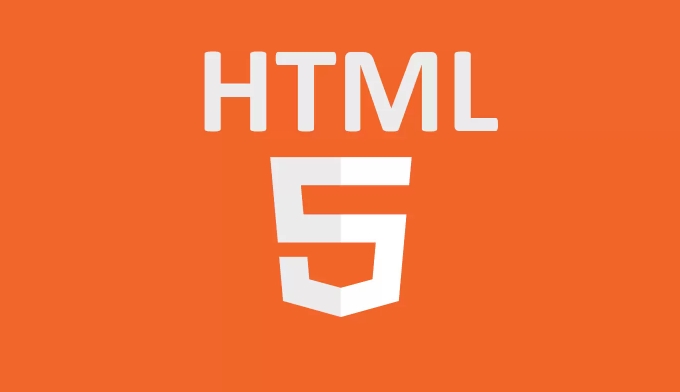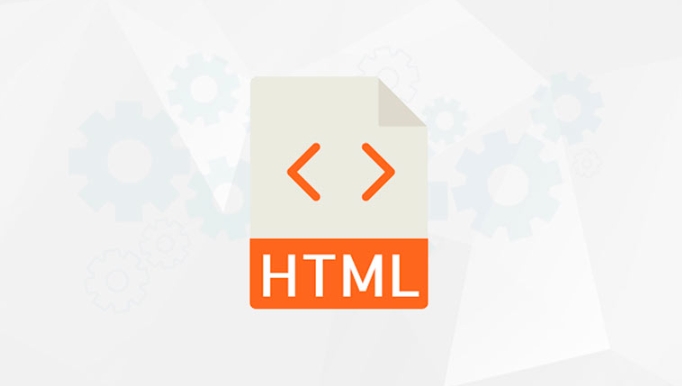The main difference between HTML and HTML5 is in its functionality, capabilities and structure. HTML is the standard markup language for creating web pages, while HTML5 is its updated version, introducing new elements, attributes, and features. 1. HTML5 has added semantic tags such as

The difference between HTML and HTML5 lies mainly in the features, capabilities, and structure they offer. HTML is the standard markup language used for creating web pages, while HTML5 is simply a newer version of HTML that introduces new elements, attributes, and functionality to help developers build more dynamic and interactive websites.

New Semantic Elements in HTML5
One of the most noticeable changes in HTML5 is the introduction of semantic tags like <header></header> , <footer></footer> , <article></article> , and <section></section> . These tags make it easier for both developers and browsers to understand the purpose of different parts of a webpage.
In older versions of HTML (often referred to as just HTML4 or XHTML), developers relied heavily on generic tags like <div> with class names such as <code>class="header" or class="nav" to structure content. HTML5 replaces many of those with meaningful tags that clearly define sections of a page. 
For example:
- Instead of using
<div id="navigation"> , you can now use <code><nav></nav>. - Instead of
<div class="main-content"> , you might use <code><main></main>.This helps improve accessibility, SEO, and code readability.

Built-in Multimedia Support
HTML5 brings native support for audio and video through the
<audio></audio>and<video></video>tags. Before HTML5, embedding media usually required third-party plugins like Flash or Silverlight.With HTML5, you can do something like this:
<video src="movie.mp4" controls></video>
And the browser handles playback without needing extra software. You can also add multiple sources for different formats and include fallback content if the browser doesn't support the tag.
Older HTML versions couldn't do that natively — you had to rely on external tools.
Improved Form Controls and Input Types
HTML5 introduced new form input types such as:
-
<input type="email"> -
<input type="date"> -
<input type="number"> -
<input type="range">
These inputs provide better user experience by showing appropriate keyboards or pickers on mobile devices and adding basic validation without requiring JavaScript.
For example:
- If you use
type="email", the browser will check if the input matches an email format. -
type="date"shows a calendar picker on supported devices.
This level of functionality wasn't available in earlier HTML versions, so developers had to use JavaScript libraries or custom code to achieve similar results.
Better Error Handling and Parsing Rules
HTML5 defines stricter parsing rules compared to older HTML standards. It ensures that browsers handle malformed HTML in a consistent way, which reduces cross-browser inconsistencies.
Also, HTML5 supports more flexible error handling, meaning even if your code isn't perfect, browsers can still render the page correctly in most cases.
No Need to Declare DTD in HTML5
Another small but practical change is that HTML5 uses a simple doctype declaration:
<!DOCTYPE html>
In contrast, older HTML versions required longer declarations tied to specific document type definitions (DTDs), like:
<!DOCTYPE html PUBLIC "-//W3C//DTD XHTML 1.0 Transitional//EN" "http://www.w3.org/TR/xhtml1/DTD/xhtml1-transitional.dtd">
This makes HTML5 cleaner and easier to write right from the start.
So, basically, HTML5 is HTML done better — it keeps what worked before and adds modern features that make development faster, more intuitive, and future-proof.
You don't need to learn two separate languages; HTML5 is just the updated version everyone uses today. -
The above is the detailed content of What's the difference between HTML and HTML5?. For more information, please follow other related articles on the PHP Chinese website!

Hot AI Tools

Undress AI Tool
Undress images for free

Undresser.AI Undress
AI-powered app for creating realistic nude photos

AI Clothes Remover
Online AI tool for removing clothes from photos.

Clothoff.io
AI clothes remover

Video Face Swap
Swap faces in any video effortlessly with our completely free AI face swap tool!

Hot Article

Hot Tools

Notepad++7.3.1
Easy-to-use and free code editor

SublimeText3 Chinese version
Chinese version, very easy to use

Zend Studio 13.0.1
Powerful PHP integrated development environment

Dreamweaver CS6
Visual web development tools

SublimeText3 Mac version
God-level code editing software (SublimeText3)
 Using ARIA attributes with HTML5 semantic elements for accessibility
Jul 07, 2025 am 02:54 AM
Using ARIA attributes with HTML5 semantic elements for accessibility
Jul 07, 2025 am 02:54 AM
The reason why ARIA and HTML5 semantic tags are needed is that although HTML5 semantic elements have accessibility meanings, ARIA can supplement semantics and enhance auxiliary technology recognition capabilities. For example, when legacy browsers lack support, components without native tags (such as modal boxes), and state updates need to be dynamically updated, ARIA provides finer granular control. HTML5 elements such as nav, main, aside correspond to ARIArole by default, and do not need to be added manually unless the default behavior needs to be overridden. The situations where ARIA should be added include: 1. Supplement the missing status information, such as using aria-expanded to represent the button expansion/collapse status; 2. Add semantic roles to non-semantic tags, such as using div role to implement tabs and match them
 Integrating CSS and JavaScript effectively with HTML5 structure.
Jul 12, 2025 am 03:01 AM
Integrating CSS and JavaScript effectively with HTML5 structure.
Jul 12, 2025 am 03:01 AM
HTML5, CSS and JavaScript should be efficiently combined with semantic tags, reasonable loading order and decoupling design. 1. Use HTML5 semantic tags, such as improving structural clarity and maintainability, which is conducive to SEO and barrier-free access; 2. CSS should be placed in, use external files and split by module to avoid inline styles and delayed loading problems; 3. JavaScript is recommended to be introduced in front, and use defer or async to load asynchronously to avoid blocking rendering; 4. Reduce strong dependence between the three, drive behavior through data-* attributes and class name control status, and improve collaboration efficiency through unified naming specifications. These methods can effectively optimize page performance and collaborate with teams.
 HTML5 video not playing in Chrome
Jul 10, 2025 am 11:20 AM
HTML5 video not playing in Chrome
Jul 10, 2025 am 11:20 AM
Common reasons why HTML5 videos don't play in Chrome include format compatibility, autoplay policy, path or MIME type errors, and browser extension interference. 1. Videos should be given priority to using MP4 (H.264) format, or provide multiple tags to adapt to different browsers; 2. Automatic playback requires adding muted attributes or triggering .play() with JavaScript after user interaction; 3. Check whether the file path is correct and ensure that the server is configured with the correct MIME type. Local testing is recommended to use a development server; 4. Ad blocking plug-in or privacy mode may prevent loading, so you can try to disable the plug-in, replace the traceless window or update the browser version to solve the problem.
 Embedding video content using the HTML5 `` tag.
Jul 07, 2025 am 02:47 AM
Embedding video content using the HTML5 `` tag.
Jul 07, 2025 am 02:47 AM
Embed web videos using HTML5 tags, supports multi-format compatibility, custom controls and responsive design. 1. Basic usage: add tags and set src and controls attributes to realize playback functions; 2. Support multi-formats: introduce different formats such as MP4, WebM, Ogg, etc. through tags to improve browser compatibility; 3. Custom appearance and behavior: hide default controls and implement style adjustment and interactive logic through CSS and JavaScript; 4. Pay attention to details: Set muted and autoplay to achieve automatic playback, use preload to control loading strategies, combine width and max-width to achieve responsive layout, and use add subtitles to enhance accessibility.
 Using HTML5 Semantic Elements for Page Structure
Jul 07, 2025 am 02:53 AM
Using HTML5 Semantic Elements for Page Structure
Jul 07, 2025 am 02:53 AM
Using HTML5 semantic tags can improve web structure clarity, accessibility and SEO effects. 1. Semantic tags such as,,,, and make it easier for the machine to understand the page content; 2. Each tag has a clear purpose: used in the top area, wrap navigation links, include core content, display independent articles, group relevant content, place sidebars, and display bottom information; 3. Avoid abuse when using it, ensure that only one per page, avoid excessive nesting, reasonable use and in blocks. Mastering these key points can make the web page structure more standardized and practical.
 Explaining the HTML5 `` vs `` elements.
Jul 12, 2025 am 03:09 AM
Explaining the HTML5 `` vs `` elements.
Jul 12, 2025 am 03:09 AM
It is a block-level element, suitable for layout; it is an inline element, suitable for wrapping text content. 1. Exclusively occupy a line, width, height and margins can be set, which are often used in structural layout; 2. No line breaks, the size is determined by the content, and is suitable for local text styles or dynamic operations; 3. When choosing, it should be judged based on whether the content needs independent space; 4. It cannot be nested and is not suitable for layout; 5. Priority is given to the use of semantic labels to improve structural clarity and accessibility.
 Accessing User Location with HTML5 Geolocation API
Jul 07, 2025 am 02:49 AM
Accessing User Location with HTML5 Geolocation API
Jul 07, 2025 am 02:49 AM
To obtain user location information, you must first obtain authorization. When using HTML5's GeolocationAPI, the first step is to request user permission. If the user refuses or fails to respond, an error should be handled and a prompt should be given; after successful authorization, the Position object includes coords (latitude, longitude, etc.) and timestamp; you can use watchPosition to monitor location changes, but you need to pay attention to performance issues and clear the listener in time. 1. Authorization requires the user to explicitly allow it to trigger the getCurrentPosition method request; 2. Process error.code when rejected or errored and prompt the user; 3. After success, position.coords provides location data; 4.watc
 Saving the content of an HTML5 canvas as an image.
Jul 08, 2025 am 02:13 AM
Saving the content of an HTML5 canvas as an image.
Jul 08, 2025 am 02:13 AM
Yes, you can save its contents as an image using the HTML5Canvas built-in toDataURL() method. First, call canvas.toDataURL ('image/png') to convert the canvas content to a base64 string in PNG format; if JPEG or WebP format is required, the corresponding type and quality parameters such as canvas.toDataURL ('image/jpeg', 0.8) can be passed in. Then you can achieve download by creating a dynamic link and triggering a click event: 1. Create an element a; 2. Set the download attribute and href as image data; 3. Call the click() method. Note that this operation should be triggered by user interaction.







